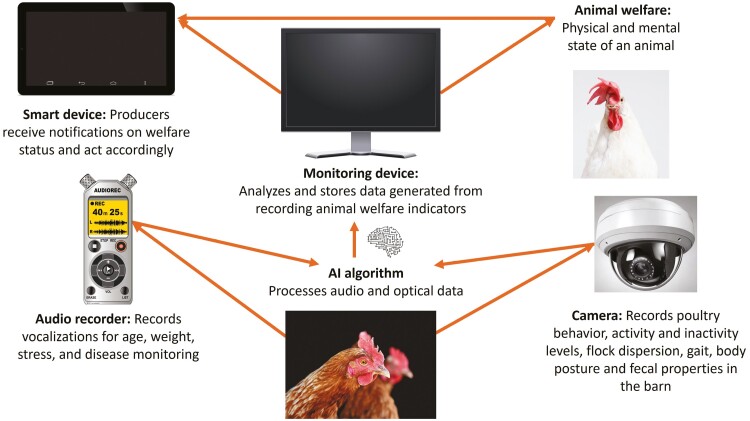Implications.
Artificial intelligence (AI) can offer an automated, practicable, and effective means of monitoring poultry welfare, with the potential of addressing public and socio-ethical concerns, but on-farm implementation remains limited.
Barriers to adopting AI for on-farm poultry monitoring include research translation, technological limitations, the diversity of animal environments, financial implications, consumers’ perspectives, and hesitation to use AI.
Collaboration among producers, researchers, consumers, policymakers, and poultry companies is critical for ensuring the transfer of AI technology from laboratories to the industry for on-farm application.
Introduction
The poultry industry is crucial to the global economy and food security. The growing world population has led to a concomitant increase in demand for poultry products, with global demand for poultry meat and eggs projected to increase to 181 and 102 million metric tons by 2050, respectively, from 82 (meat) and 62 (eggs) tons in 2005 (Smith et al., 2015). Meeting this demand requires intensive, large-scale poultry production, characterized by significant environmental footprints and growing public concern over the welfare of farmed animals.
Animal welfare refers to an animal’s physical and mental state relative to the animal’s living conditions. Although tracking the welfare status at the individual level is desirable, individual welfare assessment is particularly challenging in poultry production, where thousands of small animals with similar appearances are housed together. Therefore, the current practice is to evaluate animal welfare at the population level, which can lead to welfare issues being overlooked.
The rapid development of artificial intelligence (AI) and its application to animal welfare assessment provide a unique opportunity to improve the monitoring of farmed poultry welfare. Collecting information about the behavior of poultry, particularly their vocalizations and movements, provides invaluable opportunities to identify potential animal welfare issues early and monitor animals in real time (Figure 1). However, despite research advancements in AI algorithms for continuous, noninvasive monitoring of live animals, the on-farm use of AI remains limited. Here, we discuss the application of AI for noninvasive poultry welfare monitoring and factors limiting the adoption and application of AI for on-farm use. Further, we discuss our perspective on potential solutions to bridge the research-practice gap.
Figure 1.
Artificial intelligence, combined with other technologies, enables real-time monitoring of animals and opportunities for the early identification of animal welfare challenges.
Artificial Intelligence for Poultry Welfare Monitoring
Growing interest in animal husbandry and welfare has engendered social licensing and many consumers prefer to purchase humanely produced poultry products certified by third-party auditors. In practice, poultry welfare assessments are performed manually on sub-samples of animals within the flock or using transects, whereby observers walk through the flock and note the prevalence and severity of various conditions impacting animal welfare. However, welfare audits are a snapshot in time, as they are performed at a particular stage of production, not throughout the production cycle because frequent physical welfare assessments of thousands of birds is time consuming and laborious. Further, restraining and handling individual birds for welfare assessment could negatively impact the animals and potentially influence the outcome of the welfare assessment. Therefore, innovative non-contact poultry welfare surveillance that encourages data-driven decision making is a solution to these on-farm welfare monitoring challenges. Data collected by AI can aid welfare assessment and auditing, as welfare audits could include retrospective examination of human–animal interactions and the overall quality of life of the flock, which could enhance public trust in animal agriculture.
In recent decades, great strides have been made in using wearable and non-contact technological tools (AI and sensors) to enhance livestock monitoring. However, the suitability of animal-worn sensors for poultry welfare monitoring is limited due to the small body size of poultry, their relatively short production cycle (e.g., meat poultry where sensors need to be attached and retrieved within a relatively short period), the cost of sensors, limitations in recovering sensors, and potential food safety concerns with animal-worn sensors ending up in animal products, necessitating the development of sensors and systems that can monitor animals from a distance. Indeed, various algorithms already exist for monitoring poultry behavior and identifying poultry production and welfare challenges. However, AI algorithms typically monitor single aspects of poultry health or behavior; animal welfare requires holistic assessment of animals, their mental state, biological health and functioning, and environmental and social interactions (Mellor and Beausoleil, 2015). Using AI for animal welfare monitoring fundamentally still relies on humans to select which measures to include in animal welfare assessments, interpret the implications of these measures, and train the AI algorithm based on their definition of animal welfare. As such, AI cannot address subjectivity associated with animal welfare assessment. Further, the ongoing evolution of AI algorithms can be beneficial (improved algorithms are needed to holistically monitor changes in animal welfare) and detrimental (constant change may hinder the adoption of AI on-farm by creating the perception that AI technologies constantly need to be updated). While the possibilities for using AI to monitor animal welfare are endless, researchers have yet to integrate various sources of data to holistically assess poultry welfare, and the use of AI is still mainly confined to the laboratory.
From the Computer to the Barn: Barriers to AI Implementation
The research-practice gap is a common phenomenon across disciplines, and animal welfare science is no exception. Weary et al. (2016) noted that innovations developed by animal welfare scientists fail to be adopted in practice within the animal agriculture industry because these innovations do not account for industry constraints.
Currently, most optical and auditory algorithms developed in the laboratory for poultry welfare monitoring are not commercially available for use in the poultry industry because they are trained and validated in controlled research environments. Therefore, the successful transfer of these technologies from research to the poultry industry hinges on the adaptability of the AI algorithms to novel, complex environments. Farms differ in structure and management; barn layout, equipment, stocking density of animals, and litter material encourage image occlusion, shadowed areas, noise that impacts auditory recordings, and confusing backgrounds on camera images. Consequently, algorithms must be trained in each barn or on footage of each environment before deployment, and there are limited to no experts offering these services. Even if algorithms that can holistically assess animal welfare are applied to video data collected from commercial farms, the number of images required to train the algorithms so that they can be applied for on-farm monitoring are as yet too time consuming to be worthwhile.
For those AI systems that can be implemented on-farm, there are additional considerations. From an economic perspective, evaluating the costs of system installation and maintenance relative to current practices is essential. Smaller operations, in particular, might struggle with justifying the necessary infrastructure adjustments and hiring trained personnel to monitor these systems. The financial burden could pose a significant barrier, especially when considering the narrow profit margins typical in smaller agricultural enterprises. Further, questions such as how to store, interpret, and use the unending stream of data generated by AI for welfare assessment remain a conundrum for producers.
Surmounting Barriers: Authors’ Perspective
Integrated algorithms for real-time poultry welfare monitoring and alarms for prompt management interventions are being developed in the laboratory with promising outcomes, and it is only a matter of time before this technology will be more accessible for on-farm use. However, the availability of AI for on-farm animal welfare monitoring does not guarantee that the technology will be used in practice. A starting point could be providing guidance on which housing system designs and environmental conditions are best suited to AI. This could be followed by the development of protocols for using AI for on-farm poultry welfare monitoring. For example, protocols could offer guidance on the height, angle, and position of cameras and microphones, necessary image and audio quality, and the model or version of the algorithm. Additionally, guidance on how to modify protocols to apply AI under unique on-farm conditions would facilitate the use of AI on-farm.
Beyond technical assistance and specialized expertise, there is a need for information into producer perspectives on AI. Previous research has demonstrated that farmers perceive risks along multiple dimensions of their operations, including traditional farm business risks, human risks and legal risks (Thompson et al., 2019). Additionally, studies show that among others, socio-psychological factors, knowledge, and technology perception are determinants of adoption decisions (Adnan et al., 2019). Thus, it is important to answer questions such as what are farmers’ attitudes toward these technologies and their adoption and what factors, beyond cost, might hinder the adoption of such technologies? Additionally, information about whether supportive policy measures can positively impact AI adoption is needed. Tax incentives, grants, low-interest loans, or even subsidies aiming to alleviate the financial burden of initial investment and ongoing maintenance costs might be sufficient to sway producers toward adoption. Likewise, information campaigns and extension-led training could help alleviate concerns and ease the transition process. Such policy support could also make the technology more accessible to a wider range of producers, including smaller operations.
As a key stakeholder group, information about public opinion regarding the use of AI in poultry and egg production, is necessary. To assist producers in making adoption decisions, it is crucial to understand whether producers and retailers can capitalize on AI generated improvements through higher prices, elicited for example through targeted food labels. Conversely, it is also possible that some consumers may prefer products from animals raised without AI assistance, necessitating a nuanced approach to marketing and adoption strategies.
Conclusion
Sustainable poultry production that includes provisions for farm animal welfare can benefit greatly from advances in AI. Animal welfare science is a multidisciplinary field; therefore, the development and adoption of AI for on-farm use requires collaboration and cross-training among stakeholders, including ethologists, producers, animal caretakers, technology specialists, policymakers, and consumers.
Acknowledgments
This work was supported by funds provided to M.A.E. by the Purdue University College of Agriculture and Purdue University Department of Animal Sciences. The views expressed in this publication are those of the author(s) and do not necessarily reflect the views or policies of the the journal or the publisher.
Contributor Information
Gideon Ajibola, Department of Animal Sciences, Purdue University, West Lafayette, IN, USA.
Valerie Kilders,, Department of Agricultural Economics, Purdue University, West Lafayette, IN, USA.
Marisa A Erasmus, Department of Animal Sciences, Purdue University, West Lafayette, IN, USA.
About the Authors
 Gideon S. Ajibola is a PhD student in the Department of Animal Sciences at Purdue University. He obtained his BS degree at Osun State University (Nigeria) and his MS degree at Purdue University. Gideon is interested in the convergence of animal welfare and artificial intelligence (AI). He seeks to understand how AI can evolve to improve livestock productivity and welfare simultaneously.
Gideon S. Ajibola is a PhD student in the Department of Animal Sciences at Purdue University. He obtained his BS degree at Osun State University (Nigeria) and his MS degree at Purdue University. Gideon is interested in the convergence of animal welfare and artificial intelligence (AI). He seeks to understand how AI can evolve to improve livestock productivity and welfare simultaneously.
 Valerie Kilders is an assistant professor in the Department of Agricultural Economics at Purdue University. She earned her BS degree from Humboldt University and her dual M.S. degree from a consortium of European Universities as well as the University of Arkansas. She was awarded her PhD from Michigan State University. Dr. Kilders research program is dedicated to understanding the dynamic nature of the food system, driven by technological innovations and societal advancements. Dr. Kilders focuses on the human component that both drives and responds to these changes. By leveraging food marketing, agribusiness, and experimental economics, she generates critical insights into the behavior of consumers, producers, and other actors within the supply chain.
Valerie Kilders is an assistant professor in the Department of Agricultural Economics at Purdue University. She earned her BS degree from Humboldt University and her dual M.S. degree from a consortium of European Universities as well as the University of Arkansas. She was awarded her PhD from Michigan State University. Dr. Kilders research program is dedicated to understanding the dynamic nature of the food system, driven by technological innovations and societal advancements. Dr. Kilders focuses on the human component that both drives and responds to these changes. By leveraging food marketing, agribusiness, and experimental economics, she generates critical insights into the behavior of consumers, producers, and other actors within the supply chain.
 Marisa A. Erasmus is an associate professor of Animal Behavior and Welfare in the Department of Animal Sciences at Purdue University. She earned her BS and MS degrees from the University of Guelph in Canada and her PhD from Michigan State University. Her research focuses on developing animal-based measures of welfare and examining the effects of environmental and management factors on animal behavior and welfare. She has a strong interest in interdisciplinary research that can help inform and guide management and welfare practices for farm animals. Her extension activities include working with the commercial poultry and livestock industries to understand and address animal welfare needs and providing educational resources about animal production and welfare. Corresponding author: merasmus@purdue.edu
Marisa A. Erasmus is an associate professor of Animal Behavior and Welfare in the Department of Animal Sciences at Purdue University. She earned her BS and MS degrees from the University of Guelph in Canada and her PhD from Michigan State University. Her research focuses on developing animal-based measures of welfare and examining the effects of environmental and management factors on animal behavior and welfare. She has a strong interest in interdisciplinary research that can help inform and guide management and welfare practices for farm animals. Her extension activities include working with the commercial poultry and livestock industries to understand and address animal welfare needs and providing educational resources about animal production and welfare. Corresponding author: merasmus@purdue.edu
Conflict of interest statement: The authors declare no competing interests.
Author Contributions
Conceptualization: Gideon Ajibola and Marisa A. Erasmus; funding acquisition: Marisa A. Erasmus; supervision: Marisa A. Erasmus; writing—original draft: Gideon Ajibola, Marisa A. Erasmus, and Valerie Kilders; writing—review & editing: Gideon Ajibola, Marisa A. Erasmus, and Valerie Kilders.
References
- Adnan, N., Nordin S.M., Bahruddin M.A., and Tareq A.H... 2019. A state-of-the-art review on facilitating sustainable agriculture through green fertilizer technology adoption: Assessing farmers behavior. Trends Food Sci Technol. 86:439–452. doi: https://doi.org/ 10.1016/j.tifs.2019.02.040 [DOI] [Google Scholar]
- Mellor, D.J., and Beausoleil N.J... 2015. Extending the ‘Five Domains’ model for animal welfare assessment to incorporate positive welfare states. Anim. Welf. 24(3):241–253. doi: https://doi.org/ 10.7120/09627286.24.3.241 [DOI] [Google Scholar]
- Smith, D., S., Lyle, A., Berry, N., Manning, M., Zaki, and A., Neely.. 2015. Internet of animal health things (IoAHT) opportunities and challenges. Cambridge, (UK): University of Cambridge. [Google Scholar]
- Thompson, N.M., Bir C., and Widmar N.J.O... 2019. Farmer perceptions of risk in 2017. Agribusiness 35(2):182–199. doi: https://doi.org/ 10.1002/agr.21566 [DOI] [Google Scholar]
- Weary, D.M., Ventura B.A., and von Keyserlingk M.A.G... 2016. Societal views and animal welfare science: understanding why the modified cage may fail and other stories. Animal. 10(2):309–317. doi: https://doi.org/ 10.1017/S1751731115001160 [DOI] [PubMed] [Google Scholar]



